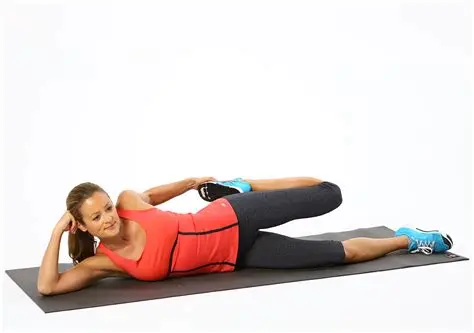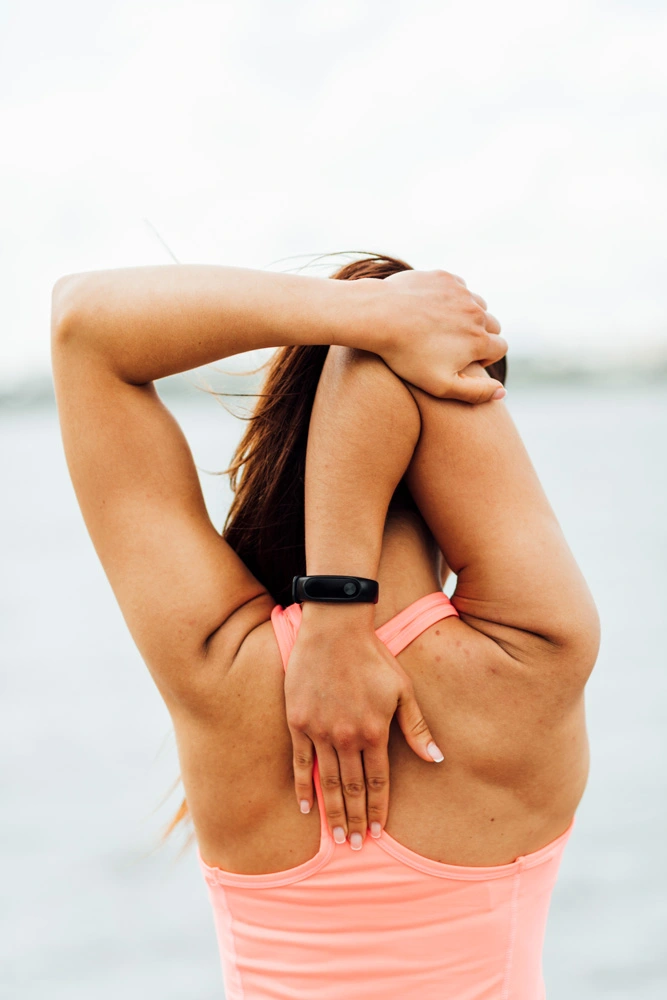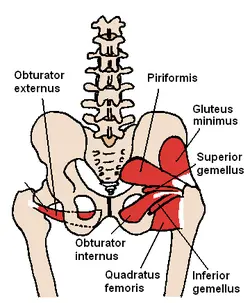31 Best Workout For Upper Chest
The upper chest is an essential area to target for a well-balanced and aesthetically pleasing physique. A strong upper chest helps to create a fuller, more defined look, complementing the overall development of the pectoral muscles.
Table of Contents
What are Your Chest Muscles?
The pectoralis major is the first and most important muscle, a large and broad muscle positioned beneath the breast that fans across the chest. It has at least six distinct sets of muscle fibers and is innervated by both the medial and lateral pectoral nerves. The pectoralis significantly permits lateral, vertical, or rotational motion by pulling on the humerus.
Naturally, the pectoralis minor lies beneath the pectoralis major and is a small, triangular muscle. The smaller of the two, it extends from three beginnings on the ribcage and aids in scapula mobility. The pectoralis major and minor form your pectoral muscles (called your “pecs”) and play an important role in arm mobility and deep inhalation.
Benefits Of Training Chest Muscles Include:
- Better posture
- Increased Power
- Increased Shoulder Joint Stability
- Transferable strength in common activities such as pushing, lifting, and carrying.
- Deeper Breathing (the chest connects to the ribs)
- So, whatever your fitness objectives are, a well-rounded chest training routine that incorporates the most excellent exercises for targeting your chest muscles can assist you in reaching them.
Best Workout For Upper Chest:
In this introduction, we will discuss the best workout routines to specifically target the upper chest muscles. These exercises are designed to isolate and engage the upper fibers of the pectoral muscles effectively. Incorporating these exercises into your fitness routine can help you achieve well-rounded chest development.
Remember, before beginning any new workout routine, it’s essential to warm up properly to prevent injuries and ensure optimal performance. Also, consult with a fitness professional or healthcare provider if you have any pre-existing medical conditions or concerns.
Traditional flat bench press
This exercise is done by lying on a flat bench and lifting a barbell at chest height up and down. It strengthens the pecs, shoulders, and arms.
Equipment required: barbell (optional additional weights) or dumbbells, flat bench
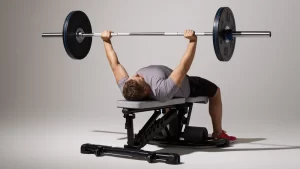
How to do it:
- Place your back on a flat bench. A barbell should be gripped with hands that are somewhat wider than shoulder width. Directly across the shoulders is where the bar should be put.
- Throughout the exercise, keep your hips on the bench and your feet firmly planted on the ground.
- Throughout the action, keep your core engaged and your spine in a neutral position. Try not to arch your back.
- Lift the bar or dumbbells slowly off the rack, if using. The elbows should be able to bend out to the side at a 45-degree angle away from the body as you lower the bar to nipple level on the chest.
- As you raise the bar back to the beginning position, plant your feet firmly on the ground.
- Depending on the weight utilized, perform 5 to 10 reps. Perform three sets.
Narrow grip bench press
It strengthens the triceps and forearms.
Barbell (extra weights optional), and a flat bench are required.
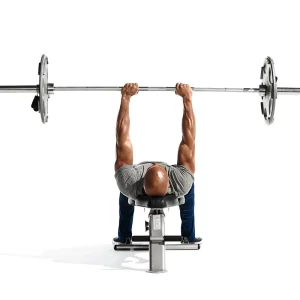
How to do it:
- Place your back on a flat bench. Throughout the action, maintain a shoulder-width grip on a barbell. The bar should be placed directly across the shoulders.
- Keep your hips on the bench and plant your feet firmly into the ground throughout the entire exercise.
- Throughout the action, keep your core engaged and your spine in a neutral position. Try not to arch your back.
- Lift the bar or dumbbells slowly off the rack, if using. The elbows should be able to bend out to the side at a 45-degree angle away from the body as you lower the bar to nipple level on the chest.
- Stop lowering yourself when your elbows are almost below the bench. Return to starting position by pressing your feet into the floor and pushing the bar back up.
- Depending on the weight utilized, perform 5 to 10 reps. Perform three sets.
Incline bench press
The upper chest and shoulder muscles are the main focus.
Two dumbbells or a barbell are required, as well as an incline bench oriented between 45 and 60 degrees.
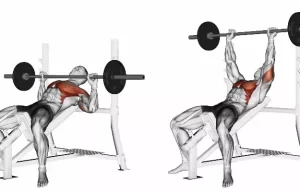
How to do it:
- Your back should rest comfortably on the bench with your feet flat on the ground and you slightly slouched back.
- Begin by immediately holding dumbbells or a barbell over your shoulders. Your hands should be facing forward, with your thumbs wrapped around the handle.
- With your elbows stretched to 45 degrees, press the weight upward above your eyes or slightly higher.
- With the elbows and wrists still out to the sides, inhale and slowly drop the dumbbells or barbells until they touch or rest just above the chest.
- Rep the press for a total of 5 reps or more. Remember that reps vary according to your goals and weight. Someone with larger weights may perform fewer reps than those with lesser weights.
Decline chest press
It strengthens the lower chest and shoulders.
A bench with a 15-degree incline is required. A reliable source and dumbbells or a barbell.
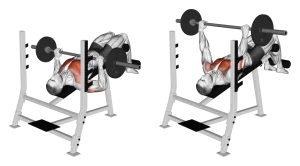
How to do it:
- Slowly lie down on the decline bench, pressing your back against the back of the bench. Put your feet in the stirrups provided.
- Allow a spotter to assist you in lifting the bar off the rack or gripping dumbbells if utilizing. Hold your weight directly over your shoulders, with your arms somewhat broader than your shoulder height.
- Push the weight up until your arms are 45 degrees inclined at the top.
- Slowly drop the weight back to chest height, elbows out to the sides.
- Rep the press for a total of 5 reps or more. Remember that reps vary according to your goals and weight. Someone with larger weights may perform fewer reps than those with lesser weights.
Knee push-ups
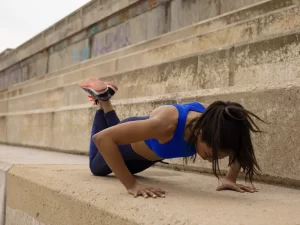
How to do it:
This version is ideal for beginners who are still working on the upper body strength required to perform a standard push-up.
Push-ups on your knees lessen resistance, making the activity easier to complete.
Begin in a modified high plank position to complete a knee push-up. Raise yourself up on your knees as opposed to your toes.
Then, proceed as if you were doing a conventional push-up. On the upward section, keep your back straight and your elbows slightly tucked.
Wall push-ups

How to do it:
- Another variation that reduces the intensity is the wall push-up. This makes it an excellent choice for individuals who are just getting started.
- Performing a push-up vertically against a wall rather than on the floor reduces resistance and makes the movement easier. The closer you are to the wall, the easier the movement.
- Your feet should be flat on the floor, and your hands should be somewhat broader than shoulder width. Descend until your head hits the wall slightly, then push off the wall to return to the starting position.
Incline push-up

How to do it:
- The incline push-up is a version in which your hands are slightly elevated on a weight bench, step-up platform, park bench, or similar.
- This significantly lessens the resistance, making the activity simpler.
- Complete the movement in the same way you would a regular push-up.
Decline-push up

How to do it:
- In contrast to the incline push-up, the decline variation uses elevated feet rather than hands.
- This increases tension in the chest muscles, making the movement slightly more difficult.
- Furthermore, this version stimulates the top pecs, also known as the pectoralis major, more than a regular push-up.
Weighted push-up
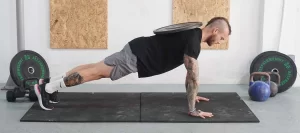
How to do it:
- Adding resistance is another technique to increase the difficulty.
- Wearing a weighted vest or having a companion lay a weight plate on your back can help.
- From there, carry out regular push-ups, being careful to keep perfect form throughout.
One-arm push-up
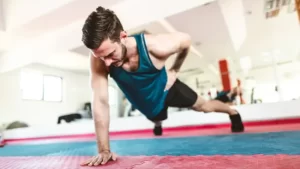
How to do it:
- The one-arm push-up is the most difficult variation of this exercise.
- This version demands you to complete a push-up using only one arm to raise and lower your body.
- You’ll set it up similarly to a typical push-up. Then, right before you drop, raise one arm behind your back and do the exercise with that arm alone.
- Only the most advanced should attempt this option because it puts a lot of strain on the working arm. It can cause damage if not done appropriately.
Dumbbell Bench Press
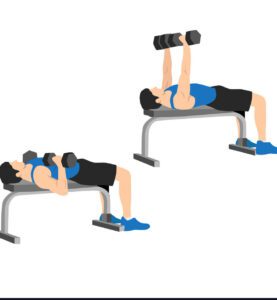
How to do it:
- Maintain extra tension in the pecs by not completely locking out the elbows.
- Maintain a 45-degree angle with the weights to keep the elbows in a neutral posture.
- Allow the dumbbells to collide at the peak of each rep; bouncing them together may cause you to lose shoulder stability and harm yourself.
- Squeeze the dumbbells as tightly as possible to improve “irradiation,” a characteristic that promotes improved shoulder stability.
- Maintain a safe position for your shoulders by pinching your shoulder blades together.
- Consider pushing yourself away from the weights rather than pushing the weights away from you.
- If you have shoulder pain (especially in the front), keep your shoulder blades slightly retracted and your shoulder girdle “packed.”
- Maintain some tightness in your abs and avoid arching your lower back excessively.
- Maintain a flat foot on the floor and do not allow your lower body to move during the set.
Alternating Dumbbell Bench Press
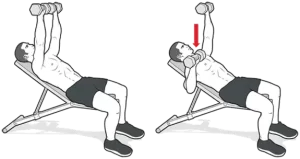
How to do it:
- Lift both dumbbells over your chest while laying face up on a bench, weights outside your shoulders, and hands towards your thighs.
- Lower the other dumbbell, touch the outside of your shoulder, and push it back up while keeping one arm straight. Push harder with both hands at the top of the movement, as if trying to punch the ceiling.
Hips-Off, Single-Arm Bench Press
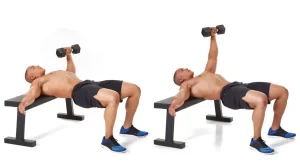
How to do it:
- Position yourself on a flat bench with your right torso lifted and a hefty (40- to 50-pound) dumbbell in your right hand.
- Brace your core and press the dumbbell over your right shoulder. Perform all reps on the right side before switching sides.
Dumbbell chest fly
Equipment needed: dumbbells, flat bench
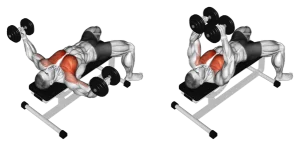
How to do it:
- Lie flat on your back on a level incline bench. Firmly place your feet on the floor on either side of the bench. Throughout the exercise, keep your head and back firmly pressed into the bench.
- Request that a spotter hand you the two dumbbells, or pick them up from the floor and hold one in each hand.
- Raise your arms above your head, extending but not locking them out. Your elbows should be slightly bent, and your palms and dumbbells should be facing each other.
- Inhale and drop dumbbells in an arc motion until they are parallel to the chest. Your arms will be at your sides but not locked out. Keep your arms over your shoulders at all times.
- Exhale and slowly raise the weights in an arc motion.
- Perform 10-15 repetitions. Rest. Perform three sets in total.
Incline bench dumbbell chest fly
Equipment needed: dumbbells, incline bench
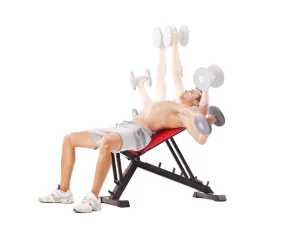
How to do it:
- Begin with your back flat on an incline bench set to 30 degrees. Take one dumbbell in each hand.
- Begin with your arms at your sides, at chest level, elbows bent and pointed out.
- Exhale slowly and raise your arms above your chest.
- Inhale and gradually lower your arms to your sides, returning to the starting posture.
- Keep pressing up.
- Perform 10-15 repetitions. Perform three sets.
Standing chest fly
It is impossible to perform a chest fly while standing with dumbbells because gravity converts it into a shoulder exercise. A resistance band, weight machine, or cable machine must be used to accomplish a standing chest fly.
Equipment needed: 2 resistance bands
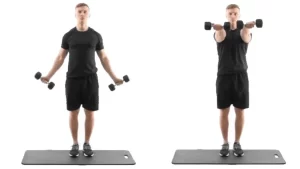
How to do it:
- Stand with your feet spaced apart and your knees slightly bent.
- Grab the Dumbelles.
- Bring your arms up straight in front of you, palms facing each other, to chest level.
- Extend your arms out to the sides completely. At all times, keep your arms close to your chest.
- Return them to the center.
- Repeat 10-15 times more. Perform three sets.
Prone Flye

How to do it:
- Place a dumbbell in each hand and perform a pushup on the floor, palms facing each other. Spread your arms out as if performing a standard dumbbell flye, then lower your body till you feel a stretch in your chest, then squeeze the dumbbells and return to the pushup position.
- Maintain a flat back and braced abs and glutes throughout. You may be able to roll the weight plates on the floor during the flye if you’re using plate-loaded dumbbells.
- Alternatively, you can place a cloth under each weight to make sliding easier. If this is too difficult, you can do the exercise on your knees.
3-Way Suspension Trainer Flye
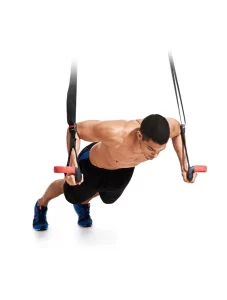
How to do it:
- Attach a suspension trainer to a sturdy overhead item and stretch the straps till you can do pushups.
- Grasp the handles and perform a pushup with your hands beneath your shoulders.
- Straighten your entire body and brace your core.
- Bring your arms out to your sides, as if you were about to give someone a bear hug.
- Bring your arms back together after lowering your body until you feel a stretch in your chest.
- That is one repetition of the flye. Rep three times.
- Then, beginning with the starting position, open your arms but maintain your elbows bent, as if doing a pushup and a flye.
- Push yourself up again.
- That’s one bent-arm flye rep.
- Rep three times.
- Return to your starting posture and complete pushups on the handles.
- All of the above adds up to one set.
Middle Cable Flye
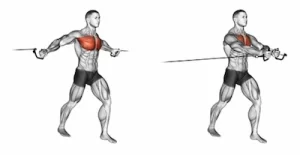
How to do it:
- Connect both cable pulley attachments with a D-handle. Take one in each hand and move out a few feet so the cables are taut.
- Maintaining elbows up and slightly bent, fists parallel to shoulders, press hands around and forward to meet, as if embracing a tree.
- Rep the reverse for 1 rep.
Pec Deck
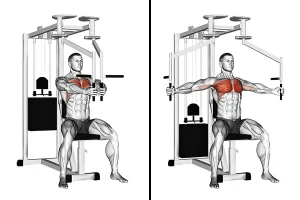
How to do it:
- Set up the Pec Deck such that the vertical bars are near the machine.
- Adjust the seat so that the handles are around chest height.
- Reach back with one hand, then the other, while facing away from the machine.
- Pull the handles together and resist tension as you return.
Wide-Grip Dips
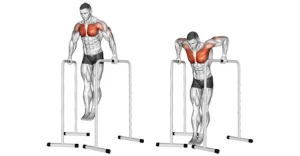
How to do it:
- Hold your body up on two parallel bars that are a few inches wider than shoulder-width apart, keeping your arms straight.
- Descend until your chest is roughly in line with your hands, then push back up to the starting position with your elbows locked out.
- Maintain a slightly horizontal body as you drop, emphasizing your chest muscles over your triceps.
One-arm Hang Snatch
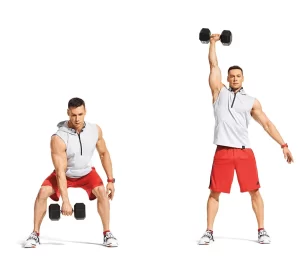
How to do it:
- It’s a full-body exercise with hip power, but your chest is the unsung hero of this move, giving stability throughout the “catch” phase.
- Stand with your feet shoulder-width apart and a dumbbell straight in front of you. Keeping your back flat and chest high, press your hips back and down to drop the weight between your knees.
- Experiment with extending the hips fast and pulling the dumbbell straight up in one move. When the weight reaches its maximum height, drop behind it and catch it overhead.
- Lower back to the beginning position and repeat; after all reps, switch sides.
Triceps kickbacks
Equipment: dumbbells
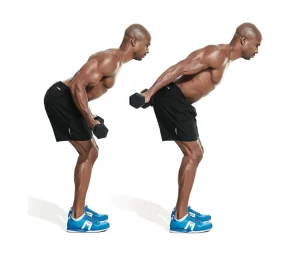
How to do it:
- Put your knees slightly bent and space your feet shoulder-width apart. Holding a dumbbell in each hand, palms facing in, perform the following exercise.
- Bend at the waist with your spine straight until your core is slanted towards the floor.
- Bend your elbows and maintain your head and spine aligned.
- Work your triceps to straighten your elbows and drive your forearms back.
- Take it from the top after pausing.
- Perform 2-3 sets of 10-15 reps.
Cable Cross-Over
Pecs, anterior deltoids, and triceps were worked.
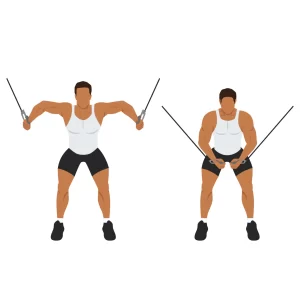
How to do it:
- Adjust the pulleys on a cable pulley machine so that they are just above shoulder height.
- Grab the handles and place yourself in the center of the machine.
- When your arms are outstretched, walk out until the cable is taut.
- Pivot from the shoulders to bring the cables down and across your chest until your hands cross over, starting with your arms slightly bent up and out to the side.
Exercise Ball Cable Flye
Pecs, anterior deltoids, and triceps were worked.

How to do it:
- Reduce the tension on the pulleys. Place an exercise ball in the center of the machine and lie down on it.
- Take hold of the cables and extend your arms to the sides. Pivot from the shoulders, keeping your elbows slightly bent, to bring your arms up and together above your chest.
- Lower, then repeat.
Plate Pressout
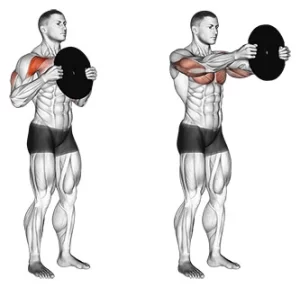
How to do it:
- Hold a pair of lightweight plates in front of your chest, smooth side out, between your palms.
- Squeeze the plates together and stretch your arms in front of you until they are fully extended, focusing on your chest.
- Stretch your lats and bring the weights back to your chest.
- Finish your reps, and then, for the second set, press the weights down at a 45-degree angle from your chest.
- Press them upward at a 45-degree angle on the third set.
Medicine Ball Pushup “Drop ‘n’ Pop”
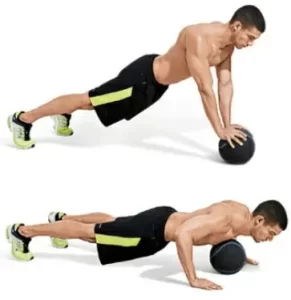
How to do it:
- Put both hands on the ball and perform a pushup.
- Let rid of the ball quickly and stretch your hands to shoulder width on the floor.
- Push yourself up rapidly when your chest meets the ball, so your hands come off the floor and land on the ball again.
Medicine Ball Crossover Pushup
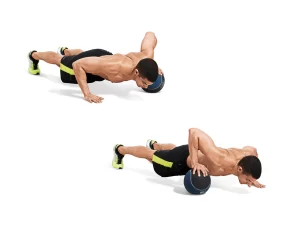
How to do it:
- Perform a pushup on the ball with one hand.
- Take your hand off the ball and roll it to the other hand at the top of the pushup.
- Repeat with your other hand and the ball.
Burpee
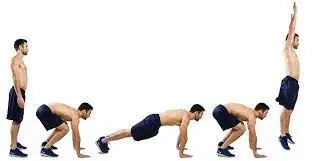
How to do it:
- Squat from a standing posture, place your hands on the ground, then “jump” your feet out to perform a pushup.
- Jump from your hands to your feet after pushing yourself up.
- Jump as high as you can while throwing your hands over your head, then instantly repeat the exercise.
Chest Dips
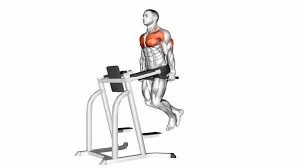
How to do it:
- Grip a parallel bar slightly wider than shoulder width.
- Raise yourself so that your elbows are fully extended over the dip bar. Use the dip bar for foot support until it’s time to begin the repetitions.
- Tilt your torso forward slightly and curl your legs at the same time. This will put pressure on your shoulders, elbows, and wrists.
- Tilt your torso somewhat more and stretch your chest forward to put your shoulders in a more secure and beneficial position.
- Inhale and start lowering yourself by breaking your elbows. Maintain a tight posture throughout the repetition.
- Lower yourself till you feel a decent stretch in your pecs (usually to 90 degrees), and then push through your elbows and exhale to return to the top.
Plyo Pushup
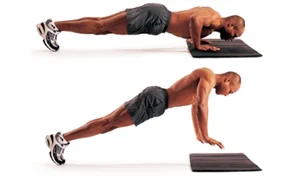
How to do it:
- Begin in a high plank or at the peak of a pushup. Your torso should be straight, your core engaged (tightened), and your palms directly beneath your shoulders.
- Begin lowering your body as though performing a pushup, until your chest is almost touching the floor.
- Your hands should leave the ground as you push yourself up with enough effort. You can enhance difficulty by clapping your hands together, although this is optional.
- Land lightly on the ground and instantly begin your next rep.
- Perform 5 to 10 reps for two or three sets. If you’re new to the move, do fewer reps; if you’re more advanced, do more.
Summary:
A well-rounded chest workout is crucial for developing strong and aesthetically pleasing chest muscles. By incorporating a variety of exercises, focusing on both compound and isolation movements, and following proper form and technique, you can maximize your chest development and achieve your desired results. A chest workout should target all areas of the chest, including the upper, middle, and lower portions, as well as the inner and outer chest. Compound exercises like bench presses, push-ups, and dips are excellent for overall chest development as they engage multiple muscle groups simultaneously. These exercises should be performed with challenging weights and proper form to stimulate muscle growth.
Additionally, isolation exercises such as dumbbell flies, cable crossovers, and pec-deck flies can help to target specific areas of the chest and enhance muscle definition. These exercises should be performed with controlled movements and a focus on the mind-muscle connection. To ensure progress and prevent plateaus, it’s essential to vary your chest workouts by incorporating different exercises, rep ranges, and training techniques. Progressive overload, gradually increasing the weight or intensity over time, is key to continued muscle growth and strength gains.
In summary, a comprehensive chest workout that combines compound and isolation exercises, proper form and technique, progressive overload, and attention to nutrition and recovery will help you achieve a strong, well-developed, and aesthetically pleasing chest. Remember to consult with a fitness professional or trainer to personalize your workout routine based on your individual goals and fitness level.
FAQs
Should I use free weights or machines for chest workouts?
Both free weights (dumbbells and barbells) and machines can be effective for chest workouts. Free weights engage more stabilizer muscles, while machines provide more stability. Incorporating a mix of both can be beneficial.
How long does it take to see results in my chest muscles?
The time it takes to see results varies depending on factors like genetics, diet, intensity of training, and consistency. Generally, noticeable improvements can be observed within a few weeks to a few months with proper training and nutrition.
Can women benefit from chest workouts?
Absolutely! Chest exercises benefit both men and women. Strengthening the chest muscles can improve posture, enhance upper body strength, and contribute to overall fitness and aesthetics.



